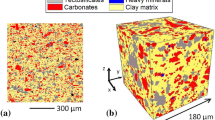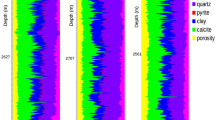Abstract
Homogenisation techniques have been successfully used to estimate the mechanical response of synthetic composite materials, due to their ability to relate the macroscopic mechanical response to the material microstructure. The adoption of these mean-field techniques in geo-composites such as shales is attractive, partly because of the practical difficulties associated with the experimental characterisation of these highly heterogeneous materials. In this paper, numerical modelling has been undertaken to investigate the applicability of homogenisation methods in predicting the macroscopic, elastic response of clayey rocks. The rocks are considered as two-level composites consisting of a porous clay matrix at the first level and a matrix-inclusion morphology at the second level. The simulated microstructures ranged from a simple system of one inclusion/void embedded in a matrix to complex, random microstructures. The effectiveness and limitations of the different homogenisation schemes were demonstrated through a comparative evaluation of the macroscopic elastic response, illustrating the appropriate schemes for upscaling the microstructure of shales. Based on the numerical simulations and existing experimental observations, a randomly distributed pore system for the micro-structure of porous clay matrix has been proposed which can be used for the subsequent development and validation of shale constitutive models. Finally, the homogenisation techniques were used to predict the experimental measurements of elastic response of shale core samples. The developed methodology is proved to be a valuable tool for verifying the accuracy and performance of the homogenisation techniques.
Similar content being viewed by others
References
Abou-Chakra Guéry, A., Cormery, F., Shao, F., Kondo, D.: A micromechanical model of elastoplastic and damage behavior of a cohesive geomaterial. Comput. Geotech. Int. J. Solids Struct. 45, 1406–1429 (2008)
Abou-Chakra Guéry, A., Cormery, F., Shao, F., Kondo, D.: A comparative micromechanical analysis of the effective properties of a geomaterial: effect of mineralogical compositions. Comput. Geotech. 37, 585–593 (2010). doi:10.1016/j.compgeo.2010.02.008
Andersen, S., Andersen, L.: Modelling of landslides with the material-point method. Comput. Geosci. 14, 137–147 (2010). doi:10.1007/s10596-009-9137-y
Andersen, S., Andersen, L.: Analysis of spatial interpolation in the material-point method. Comput. Struct. 88, 506–518 (2010). doi:10.1016/j.compstruc.2010.01.004
Bardenhagen, S.G., Kober, E.M.: The generalized interpolation material point method. Comput. Model. Eng. Sci. 5(6), 477–495 (2004)
Bass, J.D.: Mineral physics and crystallography. In: Ahrens, T.J. (ed.) A Handbook of Physical Constants. AGU Reference Shelf (1995)
Benveniste, Y.: Revisiting the generalized Self-Consistent Scheme in composites: clarification of some aspects and a new formulation. J. Mech. Phys. Solids 56, 2984–3002 (2008)
Beuth, L., Wieckowski, Z., Vermeer, P.A.: Solution of quasi-static large-strain problems by the material point method. Int. J. Numer. Anal. Methods Geomech. 35, 1451–1465 (2011). doi:10.1002/nag.965
Bobko, C., Ulm, F.J.: The nano-mechanical morphology of shale. Mech. Mater. 40, 318–337 (2008). doi:10.1016/j.mechmat.2007.09.006
Chalmers, G.R., Bustin, R.M., Power, I.M.: Characterization of gas shale pore systems by porosimetry, pycnometry, surface area, and field emission scanning electron microscopy/transmission electron microscopy image analyses: examples from the Barnett, Woodford, Haynesville, Marcellus, and Doig units. Am. Assoc. Petrol Geol. (AAPG) Bull. 96(6), 1099–1119 (2012)
Chateau, X., Dormieux, L.: Micromechanics of saturated and unsaturated porous media. Int. J. Numer. Anal. Methods Geomech. 26, 831–844 (2002). doi:10.1002/nag.227
Chen, L., Zhang, L., Kang, Q., Viswanathan, H.S., Yao, J., Tao, W.: Nanoscale simulation of shale transport properties using the lattice Boltzmann method: permeability and diffusivity. Sci. Rep. 5(8089) (2015)
Christensen, R.M., Lo, K.H.: Solutions for effective and shear properties in three phase and cylinder models. J. Mech. Phys. Solids 27, 315–330 (1979)
Domnesteanu, P., McCann, C., Sothcott, J.: Velocity anisotropy and attenuation of shale in under- and overpressured conditions. Geophys. Prospect. 50, 487–503 (2002)
Fritsch, A., Hellmich, C.: Universal microstructural patterns in cortical and trabecular, extracellular and extravascular bone materials: micromechanics-based prediction of anisotropic elasticity. J. Theor. Biol. 224, 597–620 (2007). doi:10.1016/j.jtbi.2006.09.013
Hbaieb, K., Wang, Q.X., Chia, Y.H.J., Cotterell, B.: Modelling stiffness of polymer/clay nanocomposites. Polymer 48, 901–909 (2007)
Hill, R.: A self-consistent mechanics of composite materials. J. Mech. Phys. Solids 13, 213–222 (1965)
Hornby, B.E., Schwartz, L., Hudson, J.: Anisotropic effective medium modeling of the elastic properties of shales. Geophysics 59, 1570–1583 (1994)
Hornby, B.E.: Experimental laboratory determination of the dynamic elastic properties of wet, drained shales. Geophys. Res. J. 103(B12), 29945–29964 (1998)
Jakobsen, M., Hudson, J.A., Johansen, T.A.: T-matrix approach to shale acoustics. Geophys. J. Int. 154, 533–558 (2003)
Jassim, I., Stolle, D., Vermeer, P.: Two-phase dynamic analysis by material point method. Int. J. Numer. Anal. Methods Geomech. (2012)
Klusemann, B., Svendsen, B.: Homogenisation methods for multi-phase elastic composites: comparisons and benchmarks. Tech. Mech. 30(4), 374–386 (2010)
Ma, J., Sanchez, J.P., Wu, K., Couples, G.D., Jiang, Z.: A pore network model for simulating non-ideal gas flow in micro- and nano-porous materials. Fuel 116, 498–508 (2014). doi:10.1016/j.fuel.2013.08.041
Maghous, S., Dormieux, L., Barthelemy, J.F.: Micromechanical approach to the strength properties of frictional geomaterials. Eur. J. Mech. A-Solid 28, 179–188 (2009). doi:10.1016/j.euromechsol.2008.03.002
Mast, C.M., Mackenzie-Helnwein, P., Arduino, P., Miller, G.R., Shin, W.: Mitigating kinematic locking in the material point method. J. Comput. Phys. 231, 5351–5373 (2012)
Mast, C.M., Arduino, P., Miller, G.R., Shin, W., Mackenzie-Helnwein, P.: Avalanche and landslide simulation using the material point method: flow dynamics and force interaction with structures. Comput. Geosci. 231, 5351–5373 (2015)
Meier, T., Rybacki, E., Reinicke, A., Dresen, G.: Influence of borehole diameter on the formation of borehole breakouts in black shale. Int. J. Rock Mech. Min. Sci. 62, 74–85 (2013). doi:10.1016/j.ijrmms.2013.03.012
Mori, T., Tanaka, K.: Average stress in matrix and average elastic energy of materials with misfitting inclusions. Acta Metall 21 (1973)
Mortazavi, B., Baniassadi, M., Bardon, J., Ahzi, S.: Modeling of two-phase random composite materials by finite element, Mori–Tanaka and strong contrast methods. Compos. Part B 45, 1117–1125 (2013)
Moussaddy, H., Therriault, D., Lévesque, M.: A numerical approximation to the elastic properties of shpare reinforced composite. In: The 19th International Conference in Composite Materials (2013)
Naraghia, M.E., Javadpour, F.: A stochastic permeability model for the shale-gas systems. Int. J. Coal Geol. 140, 111–124 (2015). doi:10.1016/j.coal.2015.02.004
Onoda, G.Y., Liniger, E.G.: Random loose packings of uniform spheres and the dilatancy onset. Phys. Rev. Lett. 64(22), 2727–2730 (1990)
Ortega, J.A., Ulm, F.J., Abousleiman, Y.N.: The effect of the nanogranular nature of shale on their poroelastic behavior. Acta Geotech. 2, 155–182 (2007). doi:10.1007/s11440-007-0038-8
Sayers, C.M.: The elastic anisotropy of shale. J. Geophy. Res. 99(B1), 767–774 (1994)
Segurado, J., Llorca, J.: A numerical approximation to the elastic properties of shpere reinforced composite. J. Mech. Phys. Solids 50, 2107–2121 (2002)
Schmauder, S., Weber, U., Soppa, E.: Computational micromechanics of heterogeneous materials. Key Eng. Mater. 251–252, 415–422 (2003)
Shen, W.Q., Shao, J.F., Kondo, D., Gatmiri, B.: A micro–macro model for clayey rocks with a plastic compressible porous matrix. Int. J. Plast. 36, 64–85 (2012). doi:10.1016/j.ijplas.2012.03.006
Shen, W.Q., Kondo, D., Dormieux, L., Shao, J.F.: A closed-form three scale model for ductile rocks with a plastically compressible porous matrix. Mech. Mater. 59, 73–86 (2013)
Sierra, R., Tran, M.H., Abousleiman, Y.N., Slatt, R.M.: Woodford shale mechanical properties and the impacts of lithofacies. In: the 44th US Rock Mech. Symp. (ARMA) 10-461 (2010)
Stransky, J., Vorel, J., Zeman, J., Sejnoha, M.: Mori-Tanaka based estimates of effective thermal conductivity of various engineering materials. Micromachines 2, 129–149 (2011). doi:10.3390/mi2020129
Sulsky, D., Chen, Z., Schreyer, H.L.: A particle method for history-dependent materials. Comput. Meth. Appl. Mech. Eng. 118(1–2), 179–196 (1994). doi:10.1016/0045-7825(94)90112-0
Sulsky, D., Schreyer, H.L.: Axisymmetric form of the material point method with applications to upsetting and Taylor impact problems. Comput. Meth. Appl. Mech. Eng/ 139(1–4), 409–429 (1996). doi:10.1016/S0045-7825(96)01091-2
Ulm, F.J., Abousleiman, Y.: The nanogranular nature of shale. Acta Geotech. 1, 77–88 (2006). doi:10.1007/s11440-006-0009-5
Vasin, R.N., Wenk, H.R., Kanitpanyacharoen, W., Matthies, S., Wirth, R.: Elastic anisotropy modeling of Kimmeridge shale. J. Geophys. Res: Solid Earth 118, 3931–3956 (2013). doi:10.1002/jgrb.50259
Vernik, L., Nur, A.: Ultrasonic velocity and anisotropy of hyrdocarbon source rocks. Geophysics 57(5), 727–735 (1992)
Whitaker, M.L., Liu, W., Wang, L., Li, B.: Acoustic velocities and elastic properties of pyrite (FeS2) to 9.6 GPa. J. Earth Sci. 21, 792–80 (2010). doi:10.1007/s12583-010-0115-z
Wieckowski, Z.: The material point method in large strain engineering problems. Comput. Meth. Appl. Mech. Eng. 193, 4417–4438 (2004). doi:10.1016/j.cma.2004.01.035
Zaoui, A.: Continuum micromechanics: survey. J. Eng. Mech. 128(8), 808–816 (2002). doi:10.1061/(ASCE)0733-9399(2002)128:8(808)
Zheng, Q.S., Du, D.X.: An explicit and universally applicable estimate for the effective properties of multiphase composites which accounts for inclusion distribution. J. Mech. Phys. Solids 49, 2765–2788 (2001)
Zhu, Y., Xu, S., Payne, M., Martinez, A., Liu, E., Harris, C., Bandyopadhyay, K.: Improved rock-physics model for shale gas reservoirs. In: 82nd SEG Meeting Expanded Abstracts 0927 (2012)
Author information
Authors and Affiliations
Corresponding author
Rights and permissions
About this article
Cite this article
Goodarzi, M., Rouainia, M. & Aplin, A.C. Numerical evaluation of mean-field homogenisation methods for predicting shale elastic response. Comput Geosci 20, 1109–1122 (2016). https://doi.org/10.1007/s10596-016-9579-y
Received:
Accepted:
Published:
Issue Date:
DOI: https://doi.org/10.1007/s10596-016-9579-y




